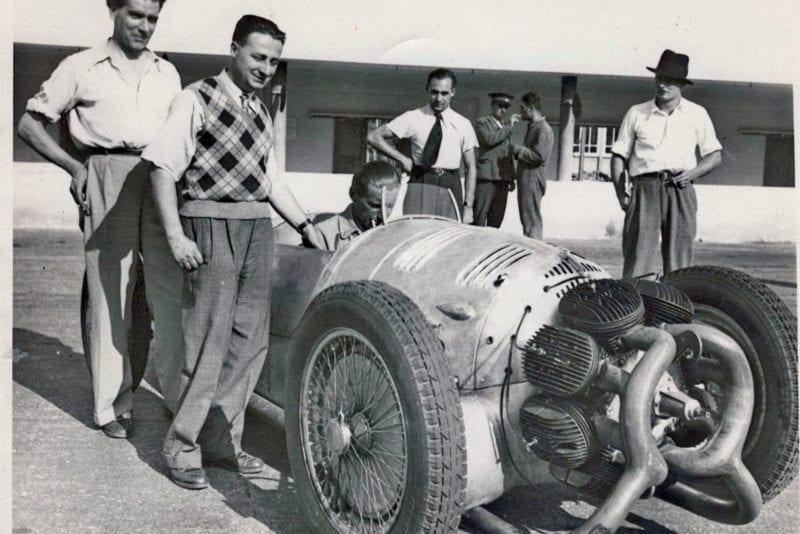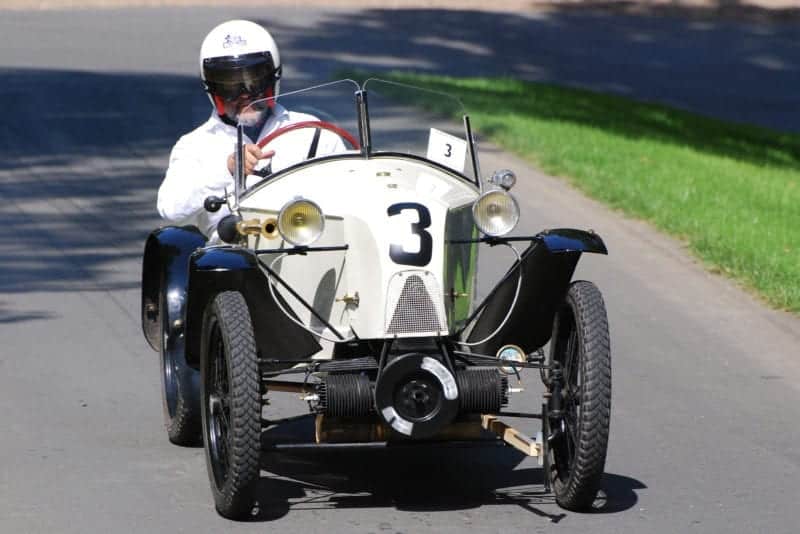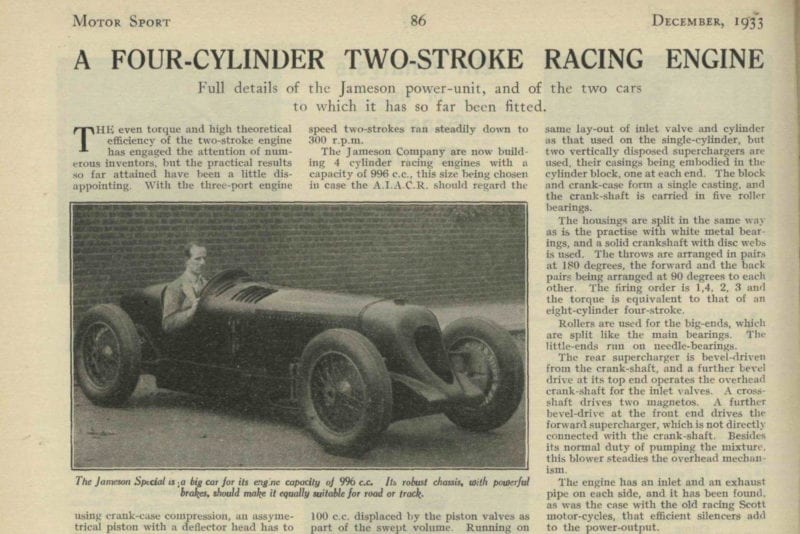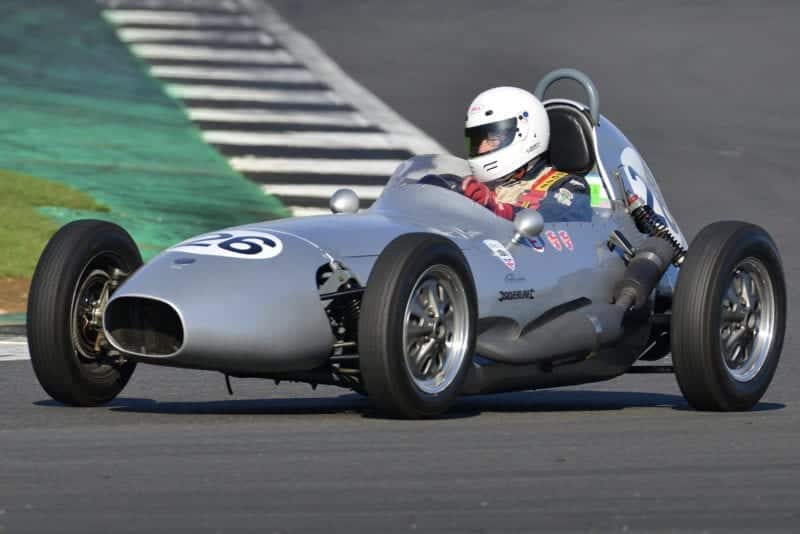Overheated and overhyped? The two-stroke's inglorious GP history
A potential two-stroke revolution is on the horizon for Formula 1 but history shows that the concept can be tricky

The Fiat-backed Trossi-Monaco
Well, ring-a-ding-ding, two-strokes in Formula 1 by 2025 – if Chief Technical Officer Pat Symonds’ recent intriguing suggestion is acted upon.
More bangs for your suck from fewer moving parts sounds like the perfect motor sporting recipe. Yet two-strokes in racing cars have tended to leave an unpleasant taste.
The mighty Fiat tried and failed in the mid-1920s to overcome the overheating problems – due to those briefer openings of the inlet ports – that stood between it and those enticing peaks of power.
Theirs was a supercharged six-cylinder with 12 opposed pistons, crankshafts geared together, that was intended to stand upright in the frame.
‘Marcel’ Violet’s iteration of the same period was a low-mounted flat-four, pairs of cylinders attached to a central crankcase and firing simultaneously – fronts, then rears – via a flat-plane crankshaft.
This unconventional Frenchman dropped this into a semi-monocoque chassis of his own design, built by SIMA, which bristled with several quirks too many – and came in 200kg under the proscribed minimum of the prevailing 1.5-litre Grand Prix formula.

‘Marcel’ Violet’s two-stroke effort
Alamy
He entered three for the Grand Prix de l’Automobile Club de France at Miramas in June 1926 – but wisely stayed away. With just 60bhp, his cars stood little chance, with or without ballast, as it turned out.
Neighbouring supercharging pioneer René Cozette met with more success, his opposed-piston ‘four’ achieving reliability that had escaped Fiat, and generating 100bhp from 1100cc.
Fitted to a slim single-seater, it broke records from 5km to 100 miles at Montlhéry before being wound up to 119mph at Arpajon – admittedly on the same August 1928 occasion that André Morel’s six-cylinder four-stroke Amilcar topped 128mph.
This was sufficient, however, for Cozette to consider tackling the Indianpolis 500 – he had been involved in Albert Guyot’s underwhelming supercharged, sleeve-valved bid of 1926 – and was testing at Montlhéry in August 1929 when the car crashed violently, killing its creator.
The two-stroke that did compete at Indy during the 1930s was of a very difficult ilk.
George Stewart was an ex-Detroit cab driver competing under the racy pseudonym of Leon Duray. He was a showman with go: his 122.391mph Indy pole average of 1928 would not be beaten until 1937.
Sadly his fabulous supercharged 1.5-litre fwd Miller thoroughbred single-seater was rendered redundant by the advent of the well-meaning (and perhaps unkindly nicknamed) ‘Junk Formula’ of 1930. This allowed only hefty two-seaters with engines of large proportion (6000cc maximum) but modest design and tune.
Superchargers, for instance, were banned. On four-strokes at least.
Thus Duray’s contender, based on a Willys-Overland Whippet chassis and incorporating Ford transmission and back axle, featured a U16 – four separate ‘squares’ of four, arranged longitudinally – two-stroke of 3818cc.
Its left-hand cylinders contained the inlets, the right- the exhausts, and each pair was linked by a common combustion chamber – with twin-spark ignition – and crankshaft journal.
Symonds insists that the latest technology will generate a much more efficient two-stroke. They should make a nice noise, too
This split-single/tandem arrangement was in favour in Europe, too, Dr Arnold Zoller’s shrill designs for DKW coming to dominate the smaller motorbike classes of the 1930s.
In 1934 this Swiss engineer, an ex-Fiat man now based in Germany, turned his attention to car racing. His 1464cc voiturette, based on a Röhr chassis and looking like a miniature Mercedes-Benz W25, was a twin-supercharged straight ‘six’ with 12 bores.
Whereas Duray’s connecting rods were of the same length, their cylinders of equal capacity, Zoller articulated a shorter ‘slave’ inlet piston from the larger exhaust ‘master’.
The theory was that opening the exhaust ports before the inlets improved scavenging of the charge, increasing the supercharging potential.
Another twist on this theme was provided by the remarkable Trossi-Monaco, a ‘flightless-plane’ – no wings, no prop – that arranged its eight pairs of finned split-singles in radial formation in the nose of a long, tapering fuselage of advanced spaceframe construction.
This Fiat-backed project – two-stroke promise was too good to ignore but still too fleeting to persist with – was completed only thanks to the munificence of talented aristo racer Count Trossi, in his castle near Biella, Italy.
Meanwhile, in a machine shop in Ewell, Surrey, Joseph Lambert Jameson was building a voiturette, the two-stroke of which was an in-line four with almost spherical, twin-spark combustion chambers, their tops closed by piston-type inlets operated by a short conrod attached to a small crankshaft that ran along the top of the engine. This method permitted a long dwell time at the closed and open positions, and quick opening and closing of the ports.
It was reported to generate 120-140bhp from its 996cc – a capacity chosen in case the governing body should regard the 100cc displaced by the piston valves to be a part of the swept volume.
This twin-supercharged – vane-types, arranged vertically, one at either end – unit was put into an ex-GP Delage V12 chassis/body that looked very Maserati-like, with its handsome cowl by Gurney Nutting.
None other than Sir Malcolm Campbell – for whom Jameson had made parts for his Bluebird LSR cars – was scheduled to drive it at Brooklands’ Whitsun meeting of 1934.
Its entry was scratched.
The same fate befell the Trossi-Monaco at the 1935 Italian Grand Prix, testing at Monza having revealed insurmountable overheating problems as well as unusual handling characteristics due to its fwd 75:25 weight distribution. It was undeniably underpowered, too – an alleged 250bhp from 3982cc – despite the presence of twin Zoller superchargers.

The Jameson Special
At least Zoller’s eponymous cars got to race, at the Avusrennen and Eifelrennen of 1934, where overheating beset them. Future Auto Union GP driver Ernst von Delius led the opening lap of the latter but stopped on the second to add coolant.
Sadly Zoller died suddenly before the year was out.
As for Duray, his sinister black machine, with its huge Roots supercharger, sounded like a winner – like a full grid-in-one – but its goose was cooked within six laps, having qualified 29th (of 40) at just 103.134mph.
He sold the car for scrap in 1932 having failed to qualify.
Symonds insists that the latest technology – direct injection, pressure charging and improved ignition systems, etc – will generate a much more efficient, cleaner, greener two-stroke.
They should make a nice noise, too, for the oldies among us.
He undoubtedly knows his stuff. But so, too, does the designer/engineer, with experience of Formula 1 cars and two-stroke GP motorbikes, to whom I spoke this week. Our interview was ostensibly on another topic and so I won’t quote him on this one, except to say that he couldn’t “quite see it”.
But let’s try to end on a positive note.
The card of the Boxing Day Brands Hatch meeting of 1959 included one of the more important races in Britain’s motor sporting development: the John Davy Trophy for Formula Juniors.
On its grid were: Scotsman James Clark Jnr, making a fractious single-seater debut in a Gemini of The Chequered Flag; the first Lola single-seater; Cooper’s first FJunior; and Colin Chapman’s first design with its engine behind the driver.
The Lotus 18 arrived late, unpainted and sans its mandatory rollover hoop. Its engine was an over-square Ford ‘cooker’ on twin carbs and a racing pipe, the intended pukka version having gone pop. And its handling was unsorted, poor Alan Stacey spinning at least twice as a result.
The Cooper of Mike McKee, powered by a BMC A-Series, was off the pace, too, and so the battle at the front was left to the front-engined machinery.

980cc Elva-DKW
Alamy
In a thrilling finish, Peter Arundell’s works Elva crossed the line 0.4 seconds ahead of Peter Ashdown’s fast-closing Lola-Ford – but did so trailing a plume of smoke, its DKW three-cylinder two-stroke having tightened dramatically after just 10 short laps.
Third was the second works Elva-DKW of Chris Threlfall, who had set fastest lap despite having the smaller – 980cc versus 1082cc – of the engines supplied by German driver/engineer Gerhard Mitter.
For a brief time, therefore, the ‘Deek’, reckoned more tunable and yet already more powerful, albeit undoubtedly thirstier, than its four-stroke rivals, was the buzz of this burgeoning scene. But by March 1960, Messrs. Chapman, Clark & Cosworth had got their combined acts together, and that was pretty much that.
And it has been ever since. And likely will be until, oh, 2025. Perhaps?
PS Arundell became the ‘King of Formula Junior’ in works Lotus-Fords.
